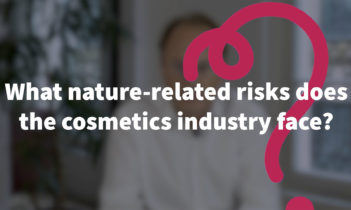
With thousands of ingredients used in today’s beauty product formulas, and the importance of packaging as the face of the product, R&D and product design teams must make critical choices about the raw materials they use.
With thousands of ingredients used in today’s beauty product formulas, and the importance of packaging as the face of the product, research and development and product design teams must make critical choices about the raw materials they use. As consumers pay closer attention to ingredient labels, R&D teams face pressure to prioritize sustainable materials. What’s more, regulatory requirements around product sustainability are intensifying, investors are scrutinizing non-financial disclosures, and retailers such as Sephora are introducing their own sustainability guidelines for brands.
In response, many cosmetics and personal care brands are looking for innovative solutions. But they often find themselves focusing on a narrow set of objectives, such as targeting specific consumer trends like natural beauty, or focusing on meeting communicated carbon emission or plastic reduction targets. This runs the risk of unintended impact shifting.
Impact shifting: A major challenge for the beauty industry
For beauty brands, impact shifting risks are particularly relevant in the widespread move towards raw materials from natural sources. Demand for bio-based feedstocks has grown as consumers perceive natural ingredients to be less chemically harmful or more sustainable. Other common sustainability priorities, such as decarbonization and reduction of plastic pollution, are also driving a shift towards natural feedstocks, both for ingredients and packaging materials. Examples include the boom in popularity of plant-based essential oils, demand for bioethanol from sugarcane, replacement of carbon-intensive silicones with bio-based esters, shifts from plastic to fiber-based packaging materials, and introduction of cellulose to replace microplastics.
But bio-based materials can have significant impacts on land use and biodiversity. In a now-familiar cautionary example, cultivation of palm oil ended up driving 7% of global deforestation between 2000 and 2018. For some inputs, such as essential oils, rising demand has also led to industrialized production. Essential oils need large amounts of raw materials for small yields, e.g., taking 50 rose petals to extract a single drop of rose oil. Industrializing their production can involve higher-impact use of fertilizers and pesticides to meet demand. Thus, these materials changes result in unintended impact shifts from one natural system to another—reducing carbon emissions while increasing water use or eliminating plastic pollution while driving up deforestation.
Impact shifting occurs even with the best intentions for sustainable transformation. Cosmetics and personal care companies must remain aware of the risks and make informed decisions.
Avoiding impact shifting requires moving from an innovation model focused on a narrow set of objectives towards a more holistic ecodesign approach to sustainable product innovation, which aims to limit overall environmental impact. Companies that identify and mitigate impact shifting risks will future-proof their material choices and speed their trajectory towards impact reduction. To make this shift, companies must take three important steps:
1. Understand the holistic impacts of raw materials and identify impact shifting risks
To make informed material innovation decisions, brands first need to perform a product Life Cycle Assessment (LCA) to assess multiple impacts across the entire product life cycle. One resource is the European Product Environmental Footprint (PEF) methodology, which includes 16 indicators measuring impacts across climate change, ecosystems, human health, resource use and water use. In collaboration with Quantis, L’Oréal developed the Sustainable Product Optimization Tool (SPOT), an ecodesign tool to evaluate the brand’s environmental performance over time.
2. Empower R&D teams to leverage impact data
Impact measurement alone is insufficient to drive sustainable innovation. Companies need to enable their teams to use impact data to inform product design choices, and can do so by:
Redesigning product development processes to include environmental impact information in the earliest design stages. Today, available impact data is often siloed within dedicated sustainability teams, leaving out R&D teams. Environmental considerations are included late in the product development process, if at all.
Integrating environmental considerations into governance structures alongside other business considerations, like profitability and efficacy. Having clear rules and structures in place can help streamline decision-making at key development stages. For instance, brands may opt to only approve products which have less impact overall than their predecessors, or which have certain sustainability characteristics.
Upskilling R&D and other teams around product sustainability and LCAs to help them understand data, develop an ecodesign mindset and arbitrate between potential impact trade-offs.
3. Work collaboratively with the value chain
Sourcing teams play a major role in integrating the most sustainable materials to reduce impact shifting risks. But this requires internal dialogue between sourcing, R&D and sustainability teams to align on objectives. Levers companies can deploy to mitigate impact shifting in the value chain include:
Applying sustainable sourcing best practices for high-risk materials, whether by relying on recognized certifications such as the Roundtable for Sustainable Palm Oil (RSPO) or the Forest Stewardship Council (FSC), or by monitoring and collaborating with suppliers on sustainable procurement policies. Working with suppliers can have the added benefit of securing supply of some short-term limited sustainable materials.
Deploying and supporting agroecology practices, such as regenerative agriculture, within their value chains. Implementing these practices at scale allows companies to move beyond impact reduction and towards positive action on nature.
Supporting continuous material innovation by working with suppliers (including startups) to develop vetted alternatives to natural feedstocks, such as algae or agricultural waste. Some fragrance brands have experimented with ethanol from carbon capture, which reduces land use and nearly eliminates water consumption, while companies looking to replace silicones may consider bio-based esters from waste.
A holistic approach to innovation
Government regulations, reporting standards, and public discourse are all evolving towards a more comprehensive view of sustainability. According to a Boston Consulting Group study 71% of skin care consumers reported sustainability concerns. In Europe and the US, recent and upcoming legislation relevant to beauty products tackles issues such as deforestation, plastic pollution reduction and regulation of ingredients deemed harmful to the environment. At the same time, the EU’s Corporate Sustainability Reporting Directive (CSRD) is evolving requirements to include not only climate change but also disclosures on companies’ impact and dependence on nature.
To future-proof products and business models and avoid impact shifting, beauty brands must apply a holistic lens and consider multiple environmental impacts in designing their products. This will ultimately empower R&D teams to produce more sustainable cosmetics and lead the industry forward.
Latest resources

4 nature-related risks facing the cosmetics industry
Quantis' Emmanuel Hembert outlines the nature risks facing the future of the cosmetics industry.

How digitalization is unlocking a new era of sustainability in fashion...
While digitalization alone doesn’t guarantee perfect accuracy, it plays a crucial role in many ways like fostering more meaningful supplier engagement, boosting data quality and...

Why an environmental sustainability strategy without nature is incomplete
Businesses have an essential role to play in reversing the trend of nature loss — and a lot to lose from inaction.


